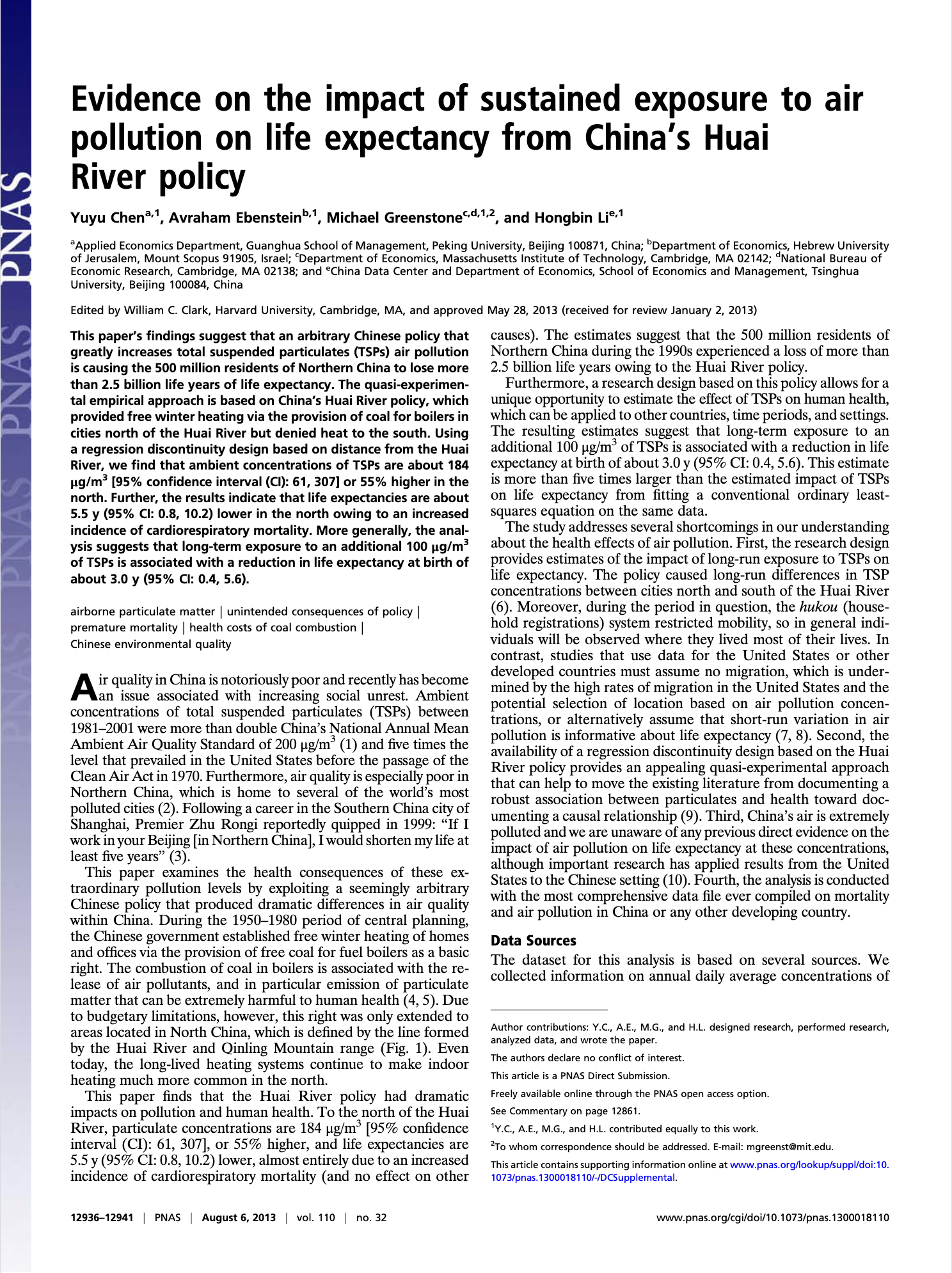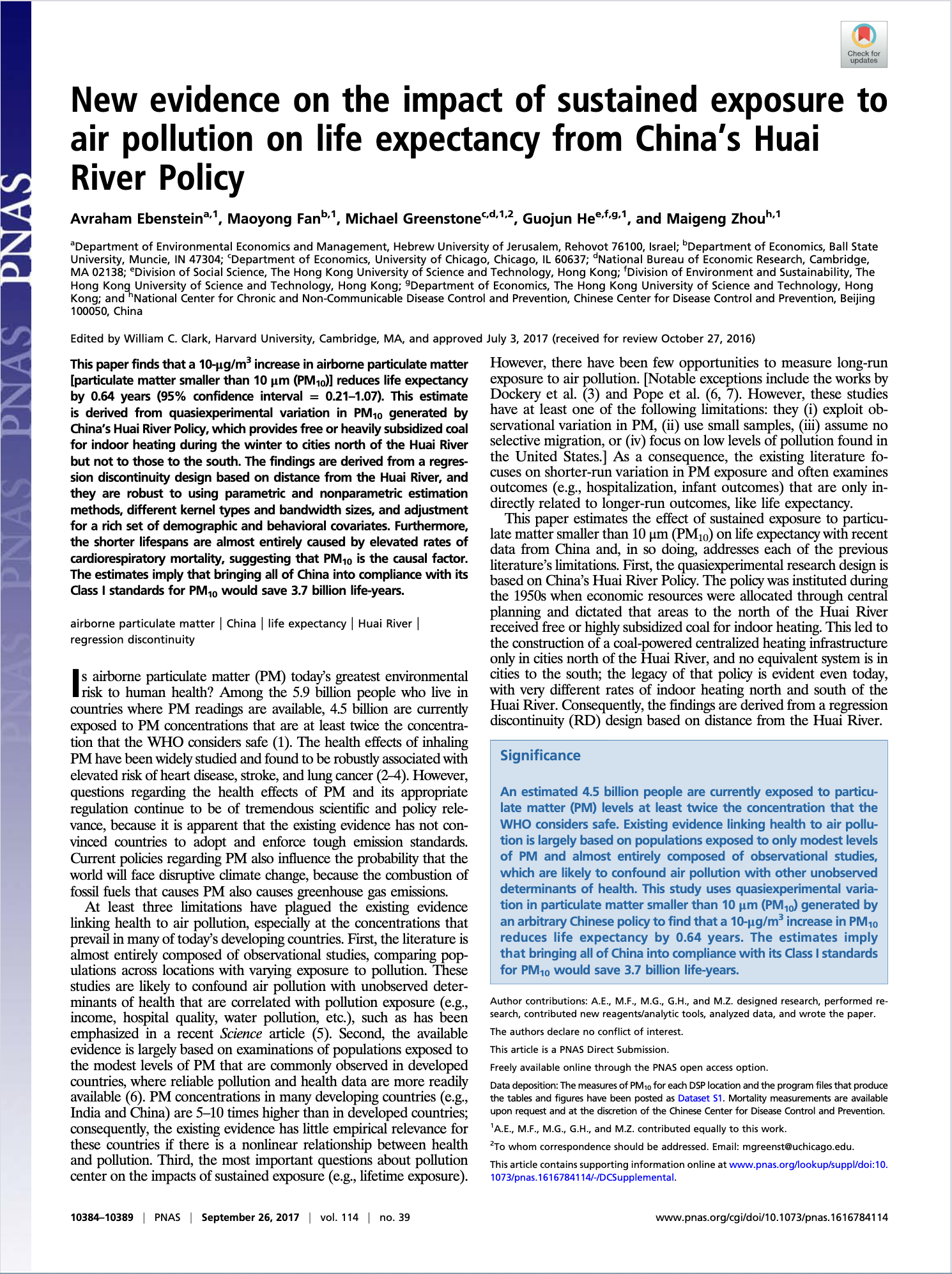क्रियाविधि
The AQLI estimates the relationship between air pollution and life expectancy. It does so by leveraging results from a pair of studies set in China. The results of the studies are combined with global population and PM₂.₅ data, as well as knowledge about air quality guidelines to estimate how much life expectancy could potentially be gained if air quality met the World Health Organization’s guideline, a national standard, or a customized standard.
Research behind the Air Quality Life Index (AQLI)
Research behind the Air Quality Life Index (AQLI)
The AQLI is based on a pair of studies set in China that, thanks to a unique social setting, were able to measure the effect of sustained exposure to high levels of pollution on a person’s life expectancy.
The effect of particulate pollution on life expectancy
The effect of particulate pollution on life expectancy











In China, the government initiated a policy in stages beginning around 1950 that gave those living north of the Huai River, where it is colder, free coal to power boilers for heating in the winter (November 15-March 15). [1]
While the policy’s purpose was to provide warmth in the winter to those who needed it the most, it resulted in a high reliance on coal north of the Huai River, relative to the south—and therefore more pollution.
At the same time, a household registration system discouraged people from leaving the communities where they were born. This effectively meant that people exposed to particulate pollution were not able to migrate to areas with cleaner air.
Combined, these two policies created a unique demarcation line where the researchers were able to study the impact of high levels of pollution over time.
They found that just north of the river air pollution concentrations were 46 percent higher than in the south. [2]
Because of the higher pollution in the north, people were living 3.1 years less than in the south.
From this quasi-experiment, the researchers were able to create a metric: Every additional 10 μg/m³ of PM⏨ reduces life expectancy by 0.64 years.
We then convert PM⏨ to PM₂.₅ based on a careful review of studies that report historical PM₂.₅-to-PM⏨ ratios in China during a similar timeframe as our foundational China studies. We derive that for every microgram per cubic meter of PM₂.₅, life expectancy is reduced by 0.98 years.
The AQLI team then combines this information with global satellite data mapping PM₂.₅ concentrations over fine grid cells (0.01° x 0.01° or 1 kilometer x 1 kilometer) covering the Earth (a dataset constructed by the Atmospheric Composition Analysis Group, ACAG, at the Washington University in St. Louis) [3]. It would take about 10 minutes to walk across a grid cell. The data is then binned to the district/county scale.
The satellite-derived PM₂.₅ dataset the AQLI team uses filters out the particulate particles that come from natural sources like dust and sea salt, focusing instead on the majority of particles—which are generated by vehicle exhaust, combustion of fossil fuels, burning crops and other human activity.
The AQLI team then combines the satellite estimates of PM₂.₅ concentrations with associated population data. This allows them to understand the number of people impacted in a given location.
The population data is used to capture the pollution levels that most people in a region are breathing. In other words, regions with low populations are given less influence on the average than regions with dense populations. This is called “population weighting.”
The population-weighted pollution estimates are then combined with the relationship between PM₂.₅ and life expectancy to calculate how many years of life people are projected to lose as a result of polluted air.
The team relates the metric to two significant benchmarks: One, the World Health Organization’s (WHO) guideline of 5 micrograms per cubic meter (μg/m³), which is the lowest level of long-term exposure that the WHO found—with high confidence—would not raise mortality.[1]
And, two, the country-specific national annual air quality standards
To give an example, if the benchmark is 5 µg/m³ and PM₂.₅ in a region is 84.34 µg/m³—as it was in Delhi in 2022—then residents could live 7.77 years longer if it reduced PM₂.₅ to meet the 5 µg/m³.
If the benchmark is India's national standard of 40µg/m³, and PM₂.₅ is 84.34 µg/m³, residents could live 3.45 years longer if the pollution was reduced to meet the 40µg/m³.
FREQUENTLY ASKED QUESTIONS
FREQUENTLY ASKED QUESTIONS
FOOTNOTES
Chen, Y., Ebenstein, A., Greenstone, M., & Li, H. 2013. “Evidence on the impact of sustained exposure to air pollution on life expectancy from China’s Huai River policy.” Proceedings of the National Academy of Sciences 110(32): 12936-12941. DOI: https://doi. org/10.1073/pnas.1300018110. (https://doi)
Ebenstein, A., Fan, M., Greenstone, M., He, G., & Zhou, M. 2017. “New evidence on the impact of sustained exposure to air pollution on life expectancy from China’s Huai River Policy.” Proceedings of the National Academy of Sciences 114(39): 10384-10389. DOI: https://doi.org/10.1073/pnas.1616784114. (https://doi.org/10.1073/pnas.1616784114)
Atmospheric Composition Analysis Group (ACAG) 2024. Data available at https://sites.wustl.edu/acag/datasets/surface-pm2-5/ (https://sites.wustl.edu/acag/datasets/surface-pm2-5/)
Aaron van Donkelaar, Melanie S. Hammer, Liam Bindle, Michael Brauer, Jeffery R. Brook, Michael J. Garay, N. Christina Hsu, Olga V. Kalashnikova, Ralph A. Kahn, Colin Lee, Robert C. Levy, Alexei Lyapustin, Andrew M. Sayer, and Randall V. Martin. 2021. “Monthly Global Estimates of Fine Particulate Matter and Their Uncertainty.” Environmental Science & Technology 55(22): 1528715300. DOI: 10.1021/acs.est.1c05309.

